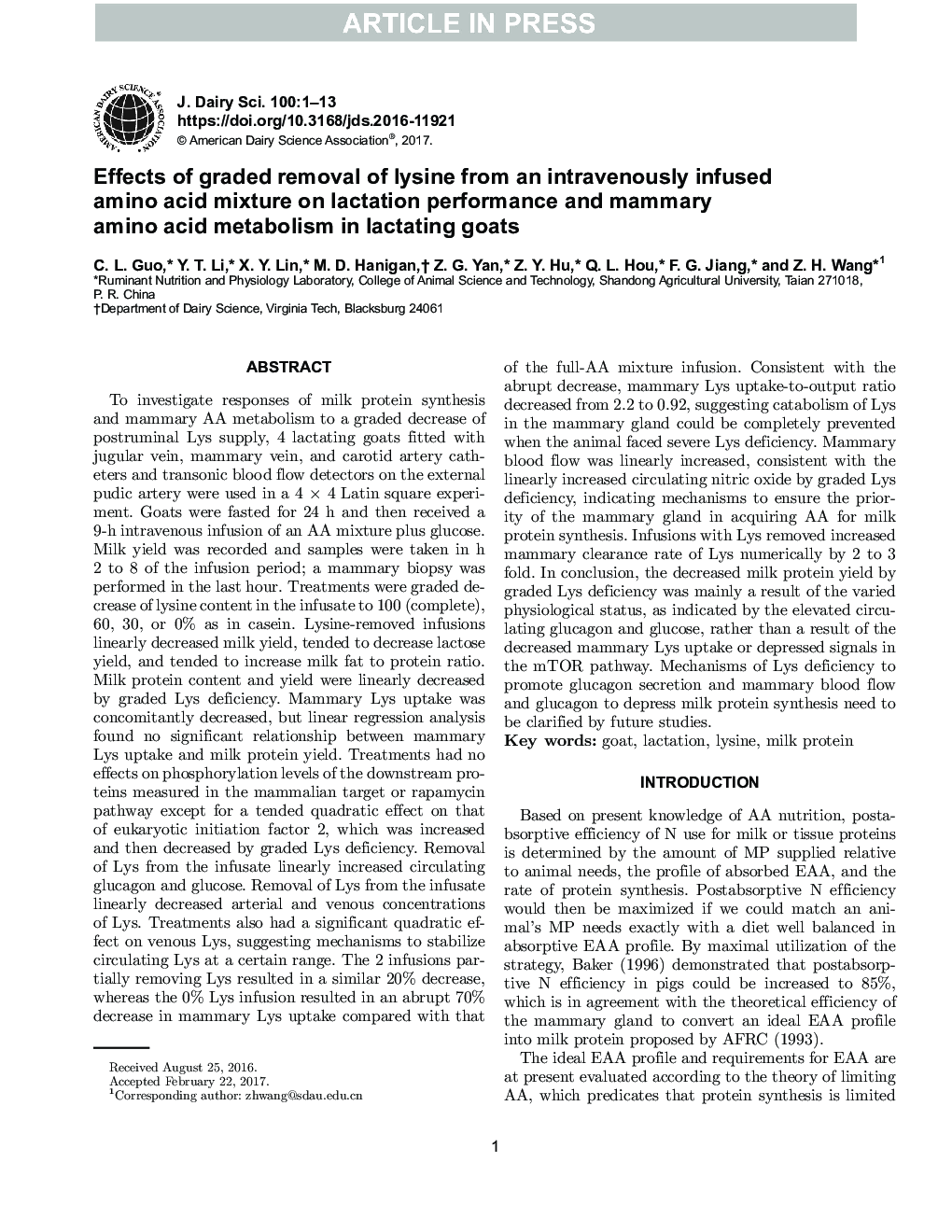| کد مقاله | کد نشریه | سال انتشار | مقاله انگلیسی | نسخه تمام متن |
|---|---|---|---|---|
| 5542252 | 1402516 | 2017 | 13 صفحه PDF | دانلود رایگان |
عنوان انگلیسی مقاله ISI
Effects of graded removal of lysine from an intravenously infused amino acid mixture on lactation performance and mammary amino acid metabolism in lactating goats
ترجمه فارسی عنوان
اثرات حذف درجه بندی لیزین از مخلوط آمینو اسید داخل وریدی تزریق شده بر عملکرد شیردهی و متابولیسم اسید آمینه اسید در بز ها شیرده
دانلود مقاله + سفارش ترجمه
دانلود مقاله ISI انگلیسی
رایگان برای ایرانیان
کلمات کلیدی
بز شیردهی، لیزین، پروتئین شیر
موضوعات مرتبط
علوم زیستی و بیوفناوری
علوم کشاورزی و بیولوژیک
علوم دامی و جانورشناسی
چکیده انگلیسی
To investigate responses of milk protein synthesis and mammary AA metabolism to a graded decrease of postruminal Lys supply, 4 lactating goats fitted with jugular vein, mammary vein, and carotid artery catheters and transonic blood flow detectors on the external pudic artery were used in a 4 Ã 4 Latin square experiment. Goats were fasted for 24 h and then received a 9-h intravenous infusion of an AA mixture plus glucose. Milk yield was recorded and samples were taken in h 2 to 8 of the infusion period; a mammary biopsy was performed in the last hour. Treatments were graded decrease of lysine content in the infusate to 100 (complete), 60, 30, or 0% as in casein. Lysine-removed infusions linearly decreased milk yield, tended to decrease lactose yield, and tended to increase milk fat to protein ratio. Milk protein content and yield were linearly decreased by graded Lys deficiency. Mammary Lys uptake was concomitantly decreased, but linear regression analysis found no significant relationship between mammary Lys uptake and milk protein yield. Treatments had no effects on phosphorylation levels of the downstream proteins measured in the mammalian target or rapamycin pathway except for a tended quadratic effect on that of eukaryotic initiation factor 2, which was increased and then decreased by graded Lys deficiency. Removal of Lys from the infusate linearly increased circulating glucagon and glucose. Removal of Lys from the infusate linearly decreased arterial and venous concentrations of Lys. Treatments also had a significant quadratic effect on venous Lys, suggesting mechanisms to stabilize circulating Lys at a certain range. The 2 infusions partially removing Lys resulted in a similar 20% decrease, whereas the 0% Lys infusion resulted in an abrupt 70% decrease in mammary Lys uptake compared with that of the full-AA mixture infusion. Consistent with the abrupt decrease, mammary Lys uptake-to-output ratio decreased from 2.2 to 0.92, suggesting catabolism of Lys in the mammary gland could be completely prevented when the animal faced severe Lys deficiency. Mammary blood flow was linearly increased, consistent with the linearly increased circulating nitric oxide by graded Lys deficiency, indicating mechanisms to ensure the priority of the mammary gland in acquiring AA for milk protein synthesis. Infusions with Lys removed increased mammary clearance rate of Lys numerically by 2 to 3 fold. In conclusion, the decreased milk protein yield by graded Lys deficiency was mainly a result of the varied physiological status, as indicated by the elevated circulating glucagon and glucose, rather than a result of the decreased mammary Lys uptake or depressed signals in the mTOR pathway. Mechanisms of Lys deficiency to promote glucagon secretion and mammary blood flow and glucagon to depress milk protein synthesis need to be clarified by future studies.
ناشر
Database: Elsevier - ScienceDirect (ساینس دایرکت)
Journal: Journal of Dairy Science - Volume 100, Issue 6, June 2017, Pages 4552-4564
Journal: Journal of Dairy Science - Volume 100, Issue 6, June 2017, Pages 4552-4564
نویسندگان
C.L. Guo, Y.T. Li, X.Y. Lin, M.D. Hanigan, Z.G. Yan, Z.Y. Hu, Q.L. Hou, F.G. Jiang, Z.H. Wang,
